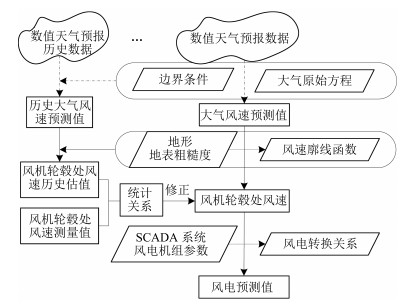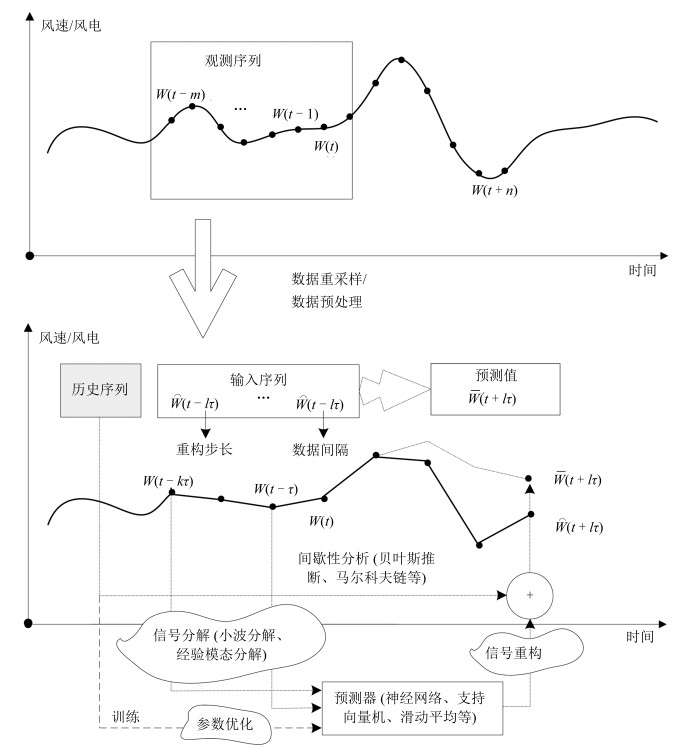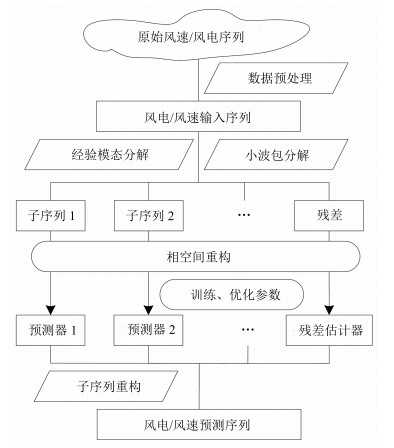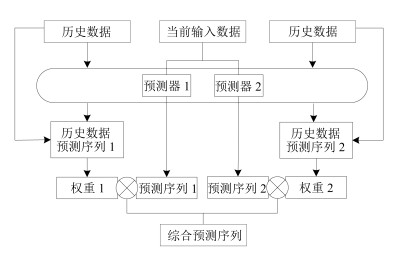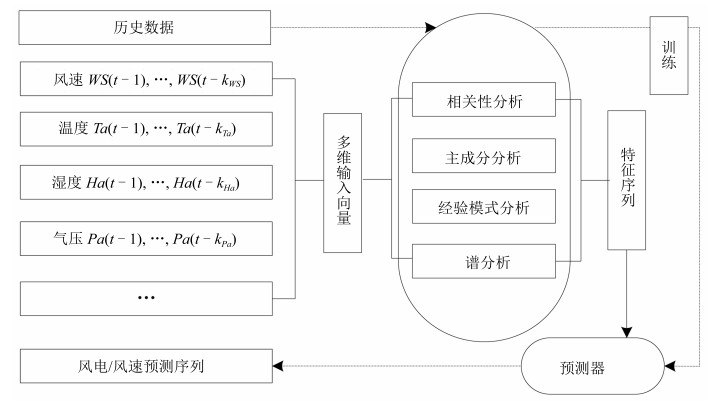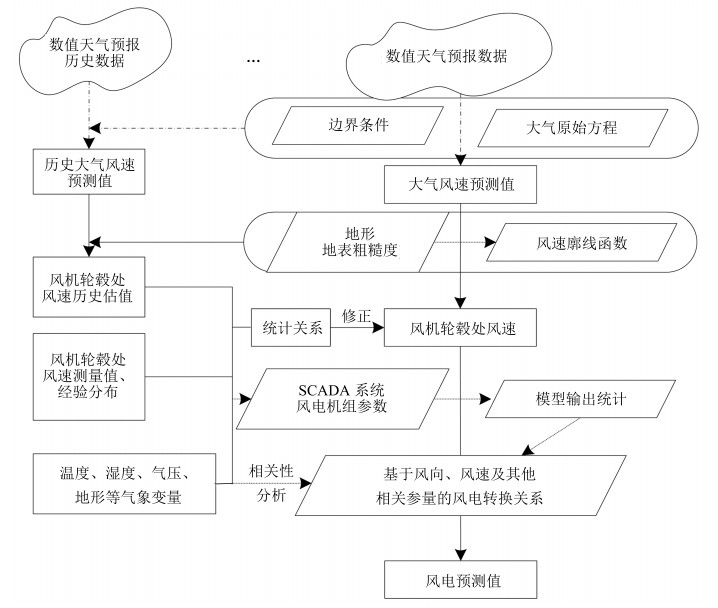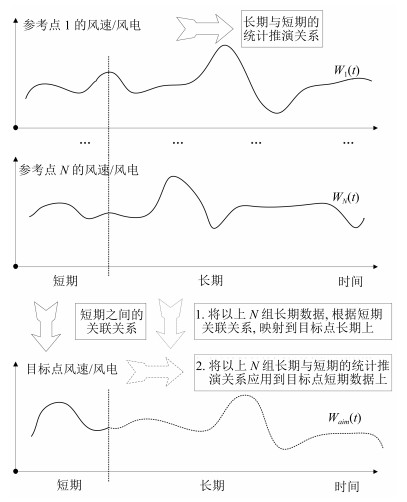-
摘要: 风能是目前世界上装机量较大的可再生能源之一,风力发电预测的精度直接影响电网的调度与安全运营.由于电网的调度策略存在多个时间点,并与涉及的地域范围有关,本文从多种时间和空间尺度的角度,综述风力发电预测方法.风力发电预测一般针对特定的空间范围和时间尺度,并在有限信息资源的条件下完成,故本文从上述三个方面综述已有研究成果.本文首先根据风力发电空间范围,从单台风力发电机、单一风电场以及风电场群三个空间尺度对研究成果进行梳理.其次在每个空间尺度上,根据风电预测是否使用气象信息将研究成果分类,并根据预测时间尺度将研究成果再次分类.最后在每个时间尺度上,根据风电预测存在的挑战,将已有的研究成果归类.通过上述梳理,本文希望可以帮助研究人员找到适合不同风电预测任务场景的方法.Abstract: Wind power is one of the most installed renewable energy resources in the world, and the accuracy of wind power forecasting method directly affects dispatching and operation safety of the power grid. Since scheduling strategy of the power grid has multiple points and is relative to the geographical scope, this paper summarizes wind power forecasting methods from multi-temporal and multi-spatial perspective. Wind power forecasting usually focuses on specific spatial scale and temporal scale, and is finished with limited information, so this paper classifies researches from three aspects above. Firstly, this paper separates existing wind power forecasting methods into three spatial scales, namely a single wind turbine, a wind farm and a group of wind farms. In each spatial scale, we classify methods by whether using meteorological information, and afterwards by temporal scales. Lastly, in each temporal scale, we also summarize the challenges and achievements. This paper wishes researchers would find suitable methodology when dealing with different wind power forecasting tasks.
-
Key words:
- Multi-scale /
- wind power /
- forecasting method /
- temporal scale /
- spatial scale
1) 本文责任编委 苏宏业 -
表 1 单台风力发电机的部分发电预测方法对比
Table 1 Comparison among part of wind power forecasting methods for a single turbine
文献 尺度 方法 输入 适用 误差 [25] 5 s 滑动平均 风速 平稳、线性 — [26] 12 h 多元回归 风电 平稳、波动小 RMSE:比常值法低4.43 % [27] 24 h 泰勒-克里格 风速 相似序列模式 RMSE:比ARIMA低15.23 % [28] 10 min 马氏链、经验分布 风电 平稳 RMSE:连续18 h内2.36 m/s [30] 5 d 指数平滑 风速 长期平稳 MAPE: 49.68 % [31] 2 d 分数-ARIMA 风速 噪声与频率反比 MSE:比常值法低42 % [32] 2 d 主成分分析、相空间重构 风电 长期平稳 NMAE:约3 %, 80 %情况下不超过12.5 % [36] 7.5 h NWP、分段转化 预报风速 测量准、地表均匀 NRMSE: 2.69 % [37] 36 h NWP、线性校正 测风速、预报风速 线性校正、长期相关 RMSE: 1.19 m/s [38] 8 d 神经网络 风速、风电、温度 预报风速转化风电 NRMSE: 2.01 % 注:误差评价标准一般包括标准均方根误差(Normalized root mean squared error, NRMSE), 均方根误差(Root mean squared error, RMSE), 相对百分比平均绝对误差(Mean absolute percentage error, MAPE), 标准平均绝对误差(Normalized mean absolute error, NMAE), 平均绝对误差(Mean absolute error, MAE), 标准均方误差(Normalized mean squared error, NMSE), 均方误差(Mean squared error, MSE), 下同. 表 2 只利用风力信息的风电场的部分发电预测方法对比
Table 2 Comparison among part of wind power forecasting methods merely using wind information for a wind farm
文献 尺度 方法 输入 适用 误差 [42] 90 min 贝叶斯推断 风速 间歇性、先验规律 RMSE:比常值法低2.796 % [43] 60 min 支持向量机、马尔科夫链 风速 间歇性、平稳 MAE: 9.1 % [44] 10 min 贝叶斯推断、马尔科夫链 风速 平稳、先验规律 RMSE:比常值法低4.57 % [47] 1 h 受限向量-ARMA 风速、风向 二维平稳 MAE: 0.809 m/s [48] 15 min 上下界估计网络 风电 平稳 — [57] 24 h 成组数据推断网络 风速 平稳 MAE: 2.176 m/s [58] 30 min 贝叶斯推断、神经网络、高斯过程 风速、风电 平稳、高斯性 NRMSE: 16.9 % [62] 3 h ARIMA、卡尔曼滤波 风速 稳定、波动小 MAPE: 2.06 % [68] 3 h 支持向量机、经验小波 风速、风电 非平稳、子序列可预测性 MAPE: 18.41 % [70] 3 h 小波支持向量机 风速 非平稳 MAPE: 10.76 % [71] 3 h 经验模态分解、神经网络 风速 非平稳、子序列可预测性 MAPE: 1.87 % [76] 30 h 自适应小波网络、前馈网络 风速、风电 长期平稳 RMSE: 10.221 % [77] 1天 ARIMA、卡尔曼滤波、神经网络 风速 长期平稳、相关 MAPE:两测试点分别为16.52 %、8.10 % [83] 1天/ 1周 小波变换、模糊网络 风电 长期平稳、偏差平稳 MAPE: 11.91 % (1天)/ 15.38 % (1周) % [85] 1天/ 1月 经验模态分解、神经网络 风速 非平稳、子序列可预测性 MAPE: 17.29 % (1天)/ 14.92 % (1月) [86] 1天 小波包变换、相空间重构 风速 非平稳、子序列可预测特征 MAPE:约20.37 % [87] 24 h 主成分分析 风速 可预测特征 MAE:比常值法低8 %$ \sim $11 % [89] 24 h 广义主成分分析 风速 隐藏可预测特征 RMSE: 2.31$ \sim $3.76 m/s [91] 24 h 珊瑚礁优化算法、神经网络 风速 隐藏可预测成分 RMSE: 2.272 m/s [93] 1年/ 1月/ 30天 多尺度数据融合、神经网络 风速 长短期分别平稳 MAE: 1年0.80 m/s, 1月0.17 m/s, 30天0.64 m/s [92] 48 h 高斯过程、神经网络 风电 短期惯性、长期间歇性 RMSE: 0.175 m/s [94] 90天 Elman递归网络、季节调整 风速 季节特征、长期平稳 MAPE: 15.32 % [97] 1天 高斯混合、高斯回归 风速 短期非平稳、季节特征 MAPE: 0.28 % [98] 5天 径向基神经网络、特征分类 风速、风电 有模式特征、长期非平稳 RMSE: 4.78 % [99] 3天 ARIMA-神经网络 风速 基本平稳 MAE:某处0.508 m/s 表 3 利用风力信息及其他气象信息的风电场的部分发电预测方法对比
Table 3 Comparison among part of wind power forecasting methods using wind information and meteorological information for a wind farm
文献 尺度 方法 输入 适用 误差 [41] 10 min 图学习、马尔科夫链 地理信息、风速、风电 间歇性、季节性、相似模式 MAPE: 3.65 %$ \sim $8.22 % [101] 10 min 洛伦兹扰动-小波神经网络 风速、气压、粗糙度、温度、湿度 预测偏差混沌、洛伦兹特性 RMSE:比小波神经网络高50 %$ \sim $70 % [102] 30 min 符号回归 风电、湿度、温度、风速 存在隐含相关性 RMSE: 12.6 % [104] 4 h 谱聚类、回声状态网络 风速、温度 平稳、存在谱特征 MAPE: 8.74 %$ \sim $11.86 % [105] 3 h 软计算、距离测度 风速、风向、温度 相似天气模式 MAPE: 9.23 %$ \sim $10.77 % [107] 1.5 h NWP、自回归、神经网络、卡尔曼滤波 风速、风电、气压、温度、预报风速 预报风速转化风电、多模型筛选、平稳 RMSE:比常值法低7 %$ \sim $65 %, 平均约48 % [108] 24 h NWP、神经网络、小波分解 风电、预报风速、温度、气压、湿度 预报风速转化风电、周期性 NMAE: 10.98 %$ \sim $18.88 % [109] 24 h NWP、高斯过程 风速、温度、湿度、气压 高斯性、预报风速转化风电 NMAE: 7.6 %$ \sim $11.12 % [111] 48 h NWP、神经网络 温度、预报风速 地表均匀 MAE: 1.8 m/s [112] 24 h NWP、模式分析 预测风速 季节规律 MAE: 2.6 m/s$ \sim $3.0 m/s [113] 48 h NWP、自适应重采样 风电、预报风速 预报风速转化置信区间 NMAE:不超过1.5 % [114] 36 h NWP、神经网络、帝国竞争算法 风电、预报的风速、湿度、温度 预报风速转化风电 RMSE: 17.2 % [115] 24 h NWP、神经网络、卡尔曼滤波 预报的风速、温度、气压、湿度 预报风速转化风电、短期平稳 NRMSE: 16.47 % [116] 36 h NWP、卡尔曼滤波、自动调谐 风电、预报风速 短期平稳、风速转化风电 RMSE:比常值法低约60 % [117] 24 h 卡尔曼滤波、$k$近邻分类 风速、风向、气温、气压、相对湿度 相似天气模式、长期非平稳 MAPE: 7.083 % [118] 31 d 混沌序列、k均值聚类 风速、气压、温度、湿度 相似天气模式、长期非平稳 MAPE: 19.21 % [119] 50 d 软计算、模型融合 风速、温度 非平稳、多模型 NMSE: 0.6515 [123] 36 h NWP、径向基网络、自组织匹配 风电、预报风速 长期平稳性、预报风速转化风电 NRMSE: 9.77 %$ \sim $13.44 % [124] 48 h NWP、粒子群优化、神经网络 风电、预报的风速、温度、湿度 预报风速转化风电、多模型筛选 NRMSE: 16.58 % [125] 72 h 卡尔曼滤波、分位点回归 风速、风电、地表粗糙度 长期平稳、地表均匀 NMAE:约10 %$ \sim $20 % 表 4 风电场群的部分发电预测方法对比
Table 4 Comparison among part of wind power forecasting methods for wind farm group
文献 尺度 方法 输入 适用 误差 [35] 4 h NWP、粒子群优化、神经网络 风电、预报的风速、温度、湿度 预报风速转化风电、多模型筛选 — [129] 1天 极限学习机、季节ARIMA 风速 惯性、平稳、季节周期 MAPE: 26.68 % [131] 3 h 自适应神经模糊扰动、小波变换、粒子群优化 风电 非平稳、子序列可预测性 MAPE: 5.81 %不等 [134] 1 h 神经网络、贝叶斯方法 风电 平稳、先验规律 RMSE:比常值法高7 %不等 [136] 1月 神经网络 风速 长期平稳 MAPE: 14.13 % [138] 12月 神经网络 风速 长期平稳 MAPE: 8.9 % [139] 12月 测量关联预测、韦伯分布 风速 空间相关性、分布平稳 NMAE: 4.8 % [141] 60天 测量关联预测 风速 空间相关性 RMSE: 0.78 % [142] 10 min 神经网络 温度、气压、辐射、风速 平稳 MAPE: 4.55 % [145] 24 h 嵌套NWP 风电密度、风速分布、预报风速 分布平稳 RMSE: 2 m/s [146] 24 h NWP、卡尔曼滤波 风速、预报风速 平稳 MAE: 2.33 m/s [147] 12 h NWP、统计升尺度、卡尔曼滤波 风电、风速、预报风速 风速转化风电、局部与总体变化相似 NRMSE: 5.51 % [148] 12 h NWP、系数贝叶斯、高斯过程 风速、风电、预测风速 平稳、先验规律、风速转化风电 MAPE: 29.87 % [149] 6 h NWP、扭曲高斯分布 风速、风电、预测风速 多模型选择、风速转化风电 MAPE: 10 % [152] 12月 NWP、测量关联预测 风速、风电、预测风速 空间相关性、风速转化风电 NMAE:风速2.8 %, 风电7.9 % -
[1] 中国可再生能源学会风能专委会. 2016年中国风电装机容量统计.风能, 2017, 2:32-44 http://d.old.wanfangdata.com.cn/Periodical/fengn201702018Chinese Wind Energy Association. Statistics of Installed Wind Power Capacity of China in 2016. Wind Energy, 2017, 2:32-44 http://d.old.wanfangdata.com.cn/Periodical/fengn201702018 [2] Bouffard F, Galiana F D. Stochastic security for operations planning with significant wind power generation. In: Proceedings of the 2008 IEEE Power and Energy Society General Meeting-Conversion and Delivery of Electrical Energy in the 21st Century. Pittsburgh, PA, USA: IEEE, 2008. 1-11 https://ieeexplore.ieee.org/document/4470561/ [3] Colak I, Sagiroglu S, Yesilbudak M. Data mining and wind power prediction:a literature review. Renewable Energy, 2012, 46:241-247 doi: 10.1016/j.renene.2012.02.015 [4] Soman S S, Zareipour H, Malik O, Mandal P. A review of wind power and wind speed forecasting methods with different time horizons. In: Proceedings of the 2010 North American Power Symposium (NAPS). Arlington, Texas, USA: IEEE, 2010. 1-8 https://ieeexplore.ieee.org/document/5619586 [5] Ata R. Artificial neural networks applications in wind energy systems:a review. Renewable and Sustainable Energy Reviews, 2015, 49:534-562 doi: 10.1016/j.rser.2015.04.166 [6] Okumus I, Dinler A. Current status of wind energy forecasting and a hybrid method for hourly predictions. Energy Conversion and Management, 2016, 123:362-371 doi: 10.1016/j.enconman.2016.06.053 [7] 彭小圣, 熊磊, 文劲宇, 程时杰, 邓迪元, 冯双磊, 等.风电集群短期及超短期功率预测精度改进方法综述.中国电机工程学报, 2016, 36(23):6315-6326 http://www.wanfangdata.com.cn/details/detail.do?_type=perio&id=QKC20162016122200097770Peng Xiao-Sheng, Xiong Lei, Wen Jin-Yu, Cheng Shi-Jie, Deng Di-Yuan, Feng Shuang-Lei, et al. A summary of the state of the art for short-term and ultra-short-term wind power prediction of regions. Proceedings of the CSEE, 2016, 36(23):6315-6326 http://www.wanfangdata.com.cn/details/detail.do?_type=perio&id=QKC20162016122200097770 [8] 叶林, 赵永宁.基于空间相关性的风电功率预测研究综述.电力系统自动化, 2014, 38(14):126-135 doi: 10.7500/AEPS20130911004Ye Lin, Zhao Yong-Ning. A review on wind power prediction based on spatial correlation approach. Automation of Electric Power Systems, 2014, 38(14):126-135 doi: 10.7500/AEPS20130911004 [9] Jiang Z Y, Jia Q S, Guan X H. Review of wind power forecasting methods: from multi-spatial and temporal perspective. In: Proceedings of the 36th Chinese Control Conference. Dalian, China: IEEE, 2017. 10576-10583 [10] Kusiak A, Zhang Z J, Verma A. Prediction, operations, and condition monitoring in wind energy. Energy, 2013, 60:1-12 doi: 10.1016/j.energy.2013.07.051 [11] Foley A M, Leahy P G, Marvuglia A, McKeogh E J. Current methods and advances in forecasting of wind power generation. Renewable Energy, 2012, 37(1):1-8 http://www.wanfangdata.com.cn/details/detail.do?_type=perio&id=def50e9bc83411d5549c91e2f486e467 [12] Jung J, Broadwater R P. Current status and future advances for wind speed and power forecasting. Renewable and Sustainable Energy Reviews, 2014, 31:762-777 doi: 10.1016/j.rser.2013.12.054 [13] Wang J Z, Song Y L, Liu F, Hou R. Analysis and application of forecasting models in wind power integration:a review of multi-step-ahead wind speed forecasting models. Renewable and Sustainable Energy Reviews, 2016, 60:960-981 doi: 10.1016/j.rser.2016.01.114 [14] Carta J A, Velázquez S, Cabrera P. A review of measure-correlate-predict (MCP) methods used to estimate long-term wind characteristics at a target site. Renewable and Sustainable Energy Reviews, 2013, 27:362-400 doi: 10.1016/j.rser.2013.07.004 [15] 叶林, 杨丹萍, 赵永宁.风电场风能资源评估的测量-关联-预测方法综述.电力系统自动化, 2016, 40(3):140-151 http://d.old.wanfangdata.com.cn/Periodical/dlxtzdh201603022Ye Lin, Yang Dan-Ping, Zhao Yong-Ning. Overview of wind resource measure-correlate-predict methods for wind farms. Automation of Electric Power Systems, 2016, 40(3):140-151 http://d.old.wanfangdata.com.cn/Periodical/dlxtzdh201603022 [16] Xiao L, Wang J Z, Dong Y, Wu J. Combined forecasting models for wind energy forecasting:a case study in China. Renewable and Sustainable Energy Reviews, 2015, 44:271-288 doi: 10.1016/j.rser.2014.12.012 [17] Tascikaraoglu A, Uzunoglu M. A review of combined approaches for prediction of short-term wind speed and power. Renewable and Sustainable Energy Reviews, 2014, 34:243-254 doi: 10.1016/j.rser.2014.03.033 [18] Zhang Y, Wang J X, Wang X F. Review on probabilistic forecasting of wind power generation. Renewable and Sustainable Energy Reviews, 2014, 32:255-270 doi: 10.1016/j.rser.2014.01.033 [19] Yan J, Liu Y Q, Han S, Wang Y M, Feng S L. Reviews on uncertainty analysis of wind power forecasting. Renewable and Sustainable Energy Reviews, 2015, 52:1322-1330 doi: 10.1016/j.rser.2015.07.197 [20] Gallego-Castillo C, Cuerva-Tejero A, Lopez-Garcia O. A review on the recent history of wind power ramp forecasting. Renewable and Sustainable Energy Reviews, 2015, 52:1148-1157 doi: 10.1016/j.rser.2015.07.154 [21] 欧阳庭辉, 查晓明, 秦亮, 熊一, 黄鹤鸣.基于相似性修正的风电功率爬坡事件预测方法.中国电机工程学报, 2017, 37(2):572580 http://www.cnki.com.cn/Article/CJFDTOTAL-ZGDC201702025.htmOuyang Ting-Hui, Zha Xiao-Ming, Qin Liang, Xiong Yi, Huang He-Ming. Wind power ramps prediction method based on amendment of similar events. Proceedings of the CSEE, 2017, 37(2):572-580 http://www.cnki.com.cn/Article/CJFDTOTAL-ZGDC201702025.htm [22] Mohammadi K, Shamshirband S, Yee P L, Petković D, Zamani M, Ch S. Predicting the wind power density based upon extreme learning machine. Energy, 2015, 86:232239 http://www.wanfangdata.com.cn/details/detail.do?_type=perio&id=2963aa64a761436f3ed56c0d39387325 [23] Yan J, Zhang H, Liu Y Q, Han S, Li L, Lu Z X. Forecasting the high penetration of wind power on multiple scales using multi-to-multi mapping. IEEE Transactions on Power Systems, 2018, 33(3):3276-3284 doi: 10.1109/TPWRS.2017.2787667 [24] Wang Y, Meng Q H, Li H X, Zeng M. Multi-scale analysis of single-point wind signals in outdoor near-surface environments. In: Proceedings of the 31st Chinese Control Conference. Hefei, China: IEEE, 2012. 3880-3885 https://ieeexplore.ieee.org/document/6057295 [25] Riahy G H, Abedi M. Short term wind speed forecasting for wind turbine applications using linear prediction method. Renewable Energy, 2008, 33(1):35-41 https://www.sciencedirect.com/science/article/pii/S0960148107000237 [26] Croonenbroeck C, Dahl C M. Accurate medium-term wind power forecasting in a censored classification framework. Energy, 2014, 73:221-232 doi: 10.1016/j.energy.2014.06.013 [27] Liu H P, Shi J, Erdem E. Prediction of wind speed time series using modified Taylor Kriging method. Energy, 2010, 35(12):4870-4879 doi: 10.1016/j.energy.2010.09.001 [28] Tang J, Brouste A, Tsui K L. Some improvements of wind speed Markov chain modeling. Renewable Energy, 2015, 81:52-56 doi: 10.1016/j.renene.2015.03.005 [29] Bossanyi E A. Short-term wind prediction using Kalman filters. Wind Engineering, 1985, 9(1):1-8 [30] Cadenas E, Jaramillo O A, Rivera W. Analysis and forecasting of wind velocity in chetumal, quintana roo, using the single exponential smoothing method. Renewable Energy, 2010, 35(5):925-930 doi: 10.1016/j.renene.2009.10.037 [31] Kavasseri R G, Seetharaman K. Day-ahead wind speed forecasting using f-ARIMA models. Renewable Energy, 2009, 34(5):1388-1393 doi: 10.1016/j.renene.2008.09.006 [32] Han L, Romero C E, Yao Z. Wind power forecasting based on principle component phase space reconstruction. Renewable Energy, 2015, 81:737-744 doi: 10.1016/j.renene.2015.03.037 [33] 陈德辉, 薛纪善.数值天气预报业务模式现状与展望.气象学报, 2004, 62(5):623-633 http://d.old.wanfangdata.com.cn/Periodical/qxxb200405009Chen De-Hui, Xue Ji-Shan. An overview on recent progresses of the operational numerical weather prediction models. Acta Meteorologica Sinica, 2004, 62(5):623-633 http://d.old.wanfangdata.com.cn/Periodical/qxxb200405009 [34] 王建成, 杨苹, 杨曦.基于数值天气预报的风电功率预测建模研究.可再生能源, 2013, 31(2):34-38 http://d.old.wanfangdata.com.cn/Periodical/ncny201302008Wang Jian-Cheng, Yang Ping, Yang Xi. Research on wind power prediction modeling based on numerical weather prediction. Renewable Energy Resources, 2013, 31(2):34-38 http://d.old.wanfangdata.com.cn/Periodical/ncny201302008 [35] Li P, Guan X H, Wu J. Aggregated wind power generation probabilistic forecasting based on particle filter. Energy Conversion and Management, 2015, 96:579-587 doi: 10.1016/j.enconman.2015.03.021 [36] Khalid M, Savkin A V. A method for short-term wind power prediction with multiple observation points. IEEE Transactions on Power Systems, 2012, 27(2):579-586 doi: 10.1109/TPWRS.2011.2160295 [37] Lazić L, Pejanović G, Živković M, Ilić L. Improved wind forecasts for wind power generation using the Eta model and MOS (model output statistics) method. Energy, 2014, 73:567-574 doi: 10.1016/j.energy.2014.06.056 [38] Peng H W, Liu F R, Yang X F. A hybrid strategy of short term wind power prediction. Renewable Energy, 2013, 50:590-595 doi: 10.1016/j.renene.2012.07.022 [39] 国家能源局.风电场功率预测预报管理暂行办法.太阳能, 2011, (14):6-7 http://d.old.wanfangdata.com.cn/Periodical/tyn201114002National Energy Administration. The interim measures on wind power forecasting management. Solar Energy, 2011, (14):6-7 http://d.old.wanfangdata.com.cn/Periodical/tyn201114002 [40] 周先春, 林万涛, 林一骅, 姚静荪, 莫嘉琪.一类扰动洛伦兹系统的解法.物理学报, 2011, 60(11):110207 doi: 10.7498/aps.60.110207Zhou Xian-Chun, Lin Wan-Tao, Lin Yi-Hua, Yao Jing-Sun, Mo Jia-Qi. A method of solving a class of disturbed Lorenz system. Acta Physica Sinica, 2011, 60(11):110207 doi: 10.7498/aps.60.110207 [41] He M, Yang L, Zhang J S, Vittal V. A spatio-temporal analysis approach for short-term forecast of wind farm generation. IEEE Transactions on Power Systems, 2014, 29(4):1611-1622 doi: 10.1109/TPWRS.2014.2299767 [42] Jiang Y, Song Z, Kusiak A. Very short-term wind speed forecasting with Bayesian structural break model. Renewable Energy, 2013, 50:637-647 doi: 10.1016/j.renene.2012.07.041 [43] Yang L, He M, Zhang J S, Vittal V. Support-vector-machine-enhanced Markov model for short-term wind power forecast. IEEE Transactions on Sustainable Energy, 2015, 6(3):791-799 http://www.springerlink.com/openurl.asp?id=doi:10.1007/978-3-319-12319-6_3 [44] Song Z, Jiang Y, Zhang Z J. Short-term wind speed forecasting with Markov-switching model. Applied Energy, 2014, 130:103-112 doi: 10.1016/j.apenergy.2014.05.026 [45] Kani S A P, Ardehali M M. Very short-term wind speed prediction:a new artificial neural network-Markov chain model. Energy Conversion and Management, 2011, 52(1):738-745 http://d.old.wanfangdata.com.cn/NSTLQK/NSTL_QKJJ0224119933/ [46] Sfetsos A. A novel approach for the forecasting of mean hourly wind speed time series. Renewable Energy, 2002, 27(2):163-174 http://www.wanfangdata.com.cn/details/detail.do?_type=perio&id=6fad6c6ac7854c14fc12871ff2851309 [47] Erdem E, Shi J. ARMA based approaches for forecasting the tuple of wind speed and direction. Applied Energy, 2011, 88(4):1405-1414 http://www.wanfangdata.com.cn/details/detail.do?_type=perio&id=30d79b742deccbd843c98d30f76b9f84 [48] Khosravi A, Nahavandi S. Combined nonparametric prediction intervals for wind power generation. IEEE Transactions on Sustainable Energy, 2013, 4(4):849-856 https://ieeexplore.ieee.org/document/6495743/ [49] Khosravi A, Nahavandi S. An optimized mean variance estimation method for uncertainty quantification of wind power forecasts. International Journal of Electrical Power and Energy Systems, 2014, 61:446-454 doi: 10.1016/j.ijepes.2014.03.060 [50] Chen K L, Yu J. Short-term wind speed prediction using an unscented Kalman filter based state-space support vector regression approach. Applied Energy, 2014, 113:690-705 doi: 10.1016/j.apenergy.2013.08.025 [51] Monfared M, Rastegar H, Kojabadi H M. A new strategy for wind speed forecasting using artificial intelligent methods. Renewable Energy, 2009, 34(3):845-848 doi: 10.1016/j.renene.2008.04.017 [52] Chitsaz H, Amjady N, Zareipour H. Wind power forecast using wavelet neural network trained by improved Clonal selection algorithm. Energy Conversion and Management, 2015, 89:588-598 doi: 10.1016/j.enconman.2014.10.001 [53] Li G, Shi J. On comparing three artificial neural networks for wind speed forecasting. Applied Energy, 2010, 87(7):2313-2320 doi: 10.1016/j.apenergy.2009.12.013 [54] Zhou J Y, Shi J, Li G. Fine tuning support vector machines for short-term wind speed forecasting. Energy Conversion and Management, 2011, 52(4):1990-1998 doi: 10.1016/j.enconman.2010.11.007 [55] Troncoso A, Salcedo-Sanz S, Casanova-Mateo C, Riquelme J C, Prieto L. Local models-based regression trees for very short-term wind speed prediction. Renewable Energy, 2015, 81:589-598 doi: 10.1016/j.renene.2015.03.071 [56] Lahouar A, Slama J B H. Hour-ahead wind power forecast based on random forests. Renewable Energy, 2017, 109:529-541 doi: 10.1016/j.renene.2017.03.064 [57] Abdel-Aal R E, Elhadidy M A, Shaahid S M. Modeling and forecasting the mean hourly wind speed time series using GMDH-based abductive networks. Renewable Energy, 2009, 34(7):1686-1699 doi: 10.1016/j.renene.2009.01.001 [58] Blonbou R. Very short-term wind power forecasting with neural networks and adaptive Bayesian learning. Renewable Energy, 2011, 36(3):1118-1124 doi: 10.1016/j.renene.2010.08.026 [59] Li G, Shi J, Zhou J Y. Bayesian adaptive combination of short-term wind speed forecasts from neural network models. Renewable Energy, 2011, 36(1):352-359 https://www.sciencedirect.com/science/article/pii/S0960148110003228 [60] Shi J, Guo J M, Zheng S T. Evaluation of hybrid forecasting approaches for wind speed and power generation time series. Renewable and Sustainable Energy Reviews, 2012, 16(5):3471-3480 doi: 10.1016/j.rser.2012.02.044 [61] Wang J Z, Heng J N, Xiao L Y, Wang C. Research and application of a combined model based on multi-objective optimization for multi-step ahead wind speed forecasting. Energy, 2017, 125:591-613 doi: 10.1016/j.energy.2017.02.150 [62] Liu H, Tian H Q, Li Y F. Comparison of two new ARIMA-ANN and ARIMA-Kalman hybrid methods for wind speed prediction. Applied Energy, 2012, 98:415-424 doi: 10.1016/j.apenergy.2012.04.001 [63] Liu H, Tian H Q, Pan D F, Li Y F. Forecasting models for wind speed using wavelet, wavelet packet, time series and Artificial Neural Networks. Applied Energy, 2013, 107:191-208 doi: 10.1016/j.apenergy.2013.02.002 [64] Bigdeli N, Afshar K, Gazafroudi A S, Ramandi M Y. A comparative study of optimal hybrid methods for wind power prediction in wind farm of Alberta, Canada. Renewable and Sustainable Energy Reviews, 2013, 27:20-29 doi: 10.1016/j.rser.2013.06.022 [65] Liu H, Tian H Q, Chen C, Li Y F. A hybrid statistical method to predict wind speed and wind power. Renewable Energy, 2010, 35(8):1857-1861 doi: 10.1016/j.renene.2009.12.011 [66] Liu H, Tian H Q, Li Y F. Four wind speed multi-step forecasting models using extreme learning machines and signal decomposing algorithms. Energy Conversion and Management, 2015, 100:16-22 doi: 10.1016/j.enconman.2015.04.057 [67] Liu H, Tian H Q, Li Y F. Comparison of new hybrid FEEMD-MLP, FEEMD-ANFIS, Wavelet Packet-MLP and Wavelet Packet-ANFIS for wind speed predictions. Energy Conversion and Management, 2015, 89:1-11 doi: 10.1016/j.enconman.2014.09.060 [68] Hu J M, Wang J Z, Ma K L. A hybrid technique for short-term wind speed prediction. Energy, 2015, 81:563-574 doi: 10.1016/j.energy.2014.12.074 [69] Liu H, Tian H Q, Chen C, Li Y F. An experimental investigation of two Wavelet-MLP hybrid frameworks for wind speed prediction using GA and PSO optimization. International Journal of Electrical Power and Energy Systems, 2013, 52:161-173 doi: 10.1016/j.ijepes.2013.03.034 [70] Zeng J W, Qiao W. Short-term wind power prediction using a wavelet support vector machine. IEEE Transactions on Sustainable Energy, 2012, 3(2):255-264 http://d.old.wanfangdata.com.cn/Periodical/xtfzxb201204007 [71] Liu H, Chen C, Tian H Q, Li Y F. A hybrid model for wind speed prediction using empirical mode decomposition and artificial neural networks. Renewable Energy, 2012, 48:545-556 doi: 10.1016/j.renene.2012.06.012 [72] Liu H, Tian H Q, Li Y F, Zhang L. Comparison of four Adaboost algorithm based artificial neural networks in wind speed predictions. Energy Conversion and Management, 2015, 92:67-81 doi: 10.1016/j.enconman.2014.12.053 [73] Zhang W Y, Qu Z X, Zhang K Q, Mao W Q, Ma Y N, Fan X. A combined model based on CEEMDAN and modified flower pollination algorithm for wind speed forecasting. Energy Conversion and Management, 2017, 136:439-451 doi: 10.1016/j.enconman.2017.01.022 [74] De Giorgi M G, Ficarella A, Tarantino M. Error analysis of short term wind power prediction models. Applied Energy, 2011, 88(4):1298-1311 http://www.sciencedirect.com/science/article/pii/S030626191000437X [75] Quan H, Srinivasan D, Khosravi A. Short-term load and wind power forecasting using neural network-based prediction intervals. IEEE Transactions on Neural Networks and Learning Systems, 2014, 25(2):303-315 doi: 10.1109/TNNLS.2013.2276053 [76] Bhaskar K, Singh S N. AWNN-assisted wind power forecasting using feed-forward neural network. IEEE Transactions on Sustainable Energy, 2012, 3(2):306-315 http://d.old.wanfangdata.com.cn/NSTLQK/NSTL_QKJJ0227437929/ [77] Shukur O B, Lee M H. Daily wind speed forecasting through hybrid KF-ANN model based on ARIMA. Renewable Energy, 2015, 76:637-647 doi: 10.1016/j.renene.2014.11.084 [78] Cadenas E, Rivera W. Wind speed forecasting in the south coast of Oaxaca, México. Renewable Energy, 2007, 32(12):2116-2128 doi: 10.1016/j.renene.2006.10.005 [79] Guo Z H, Zhao J, Zhang W Y, Wang J Z. A corrected hybrid approach for wind speed prediction in Hexi Corridor of China. Energy, 2011, 36(3):1668-1679 http://www.wanfangdata.com.cn/details/detail.do?_type=perio&id=1f8e3a8d67b87d01a903a72c0d0d4ff2 [80] Ren C, An N, Wang J Z, Li L, Hu B, Shang D. Optimal parameters selection for BP neural network based on particle swarm optimization:a case study of wind speed forecasting. Knowledge-Based Systems, 2014, 56:226-239 doi: 10.1016/j.knosys.2013.11.015 [81] Bessa R J, Miranda V, Gama J. Entropy and correntropy against minimum square error in offline and online three-day ahead wind power forecasting. IEEE Transactions on Power Systems, 2009, 24(4):1657-1666 doi: 10.1109/TPWRS.2009.2030291 [82] Chang G W, Lu H J, Chang Y R, Lee Y D. An improved neural network-based approach for short-term wind speed and power forecast. Renewable Energy, 2017, 105:301311 http://www.wanfangdata.com.cn/details/detail.do?_type=perio&id=17095c0188f68926c9b9b2f0ca0b61b2 [83] Haque A U, Nehrir M H, Mandal P. A hybrid intelligent model for deterministic and quantile regression approach for probabilistic wind power forecasting. IEEE Transactions on Power Systems, 2014, 29(4):1663-1672 doi: 10.1109/TPWRS.2014.2299801 [84] Hu J M, Wang J Z, Zeng G W. A hybrid forecasting approach applied to wind speed time series. Renewable Energy, 2013, 60:185-194 doi: 10.1016/j.renene.2013.05.012 [85] Guo Z H, Zhao W G, Lu H Y, Wang J Z. Multi-step forecasting for wind speed using a modified EMD-based artificial neural network model. Renewable Energy, 2012, 37(1):241-249 http://www.wanfangdata.com.cn/details/detail.do?_type=perio&id=cb47941592517b3fe9b5f1dbf0ff595a [86] Wang J Z, Wang Y, Jiang P. The study and application of a novel hybrid forecasting model -a case study of wind speed forecasting in China. Applied Energy, 2015, 143:472-488 doi: 10.1016/j.apenergy.2015.01.038 [87] Skittides C, Früh W G. Wind forecasting using principal component analysis. Renewable Energy, 2014, 69:365374 http://d.old.wanfangdata.com.cn/Periodical/jdq201411008 [88] Yeh W C, Yeh Y M, Chang P C, Ke Y C, Chung V. Forecasting wind power in the Mai Liao Wind Farm based on the multi-layer perceptron artificial neural network model with improved simplified swarm optimization. International Journal of Electrical Power and Energy Systems, 2014, 55:741-748 doi: 10.1016/j.ijepes.2013.10.001 [89] Hu Q H, Su P Y, Yu D R, Liu J F. Pattern-based wind speed prediction based on generalized principal component analysis. IEEE Transactions on Sustainable Energy, 2014, 5(3):866-874 http://www.wanfangdata.com.cn/details/detail.do?_type=perio&id=c1474b409233a81c6360fc1ee5fb65c2 [90] Kusiak A, Zheng H Y, Song Z. Models for monitoring wind farm power. Renewable Energy, 2009, 34(3):583-590 [91] Salcedo-Sanz S, Pastor-Sánchez A, Del Ser J, Prieto L, Geem Z W. A coral reefs optimization algorithm with harmony search operators for accurate wind speed prediction. Renewable Energy, 2015, 75:93-101 doi: 10.1016/j.renene.2014.09.027 [92] Lee D, Baldick R. Short-term wind power ensemble prediction based on Gaussian processes and neural networks. IEEE Transactions on Smart Grid, 2014, 5(1):501-510 doi: 10.1109/TSG.2013.2280649 [93] Azad H B, Mekhilef S, Ganapathy V G. Long-term wind speed forecasting and general pattern recognition using neural networks. IEEE Transactions on Sustainable Energy, 2014, 5(2):546-553 http://d.old.wanfangdata.com.cn/NSTLQK/NSTL_QKJJ0232093054/ [94] Wang J Z, Qin S S, Zhou Q P, Jiang H Y. Medium-term wind speeds forecasting utilizing hybrid models for three different sites in Xinjiang, China. Renewable Energy, 2015, 76:91-101 doi: 10.1016/j.renene.2014.11.011 [95] Zhang W Y, Wu J, Wang J Z, Zhao W G, Shen L. Performance analysis of four modified approaches for wind speed forecasting. Applied Energy, 2012, 99:324-333 doi: 10.1016/j.apenergy.2012.05.029 [96] Akçay H, Filik T. Short-term wind speed forecasting by spectral analysis from long-term observations with missing values. Applied Energy, 2017, 191:653-662 doi: 10.1016/j.apenergy.2017.01.063 [97] Yu J, Chen K L, Mori J, Rashid M M. A Gaussian mixture copula model based localized Gaussian process regression approach for long-term wind speed prediction. Energy, 2013, 61:673-686 doi: 10.1016/j.energy.2013.09.013 [98] Liu Y Q, Gao X L, Yan J, Han S, Infield D G. Clustering methods of wind turbines and its application in short-term wind power forecasts. Journal of Renewable and Sustainable Energy, 2014, 6(5):053119 doi: 10.1063/1.4898361 [99] Cadenas E, Rivera W. Wind speed forecasting in three different regions of Mexico, using a hybrid ARIMA-ANN model. Renewable Energy, 2010, 35(12):2732-2738 doi: 10.1016/j.renene.2010.04.022 [100] Liu J Q, Wang X R, Lu Y. A novel hybrid methodology for short-term wind power forecasting based on adaptive neuro-fuzzy inference system. Renewable Energy, 2017, 103:620-629 doi: 10.1016/j.renene.2016.10.074 [101] Zhang Y G, Yang J Y, Wang K C, Wang Z P, Wang Y D. Improved wind prediction based on the Lorenz system. Renewable Energy, 2015, 81:219-226 doi: 10.1016/j.renene.2015.03.039 [102] Vladislavleva E, Friedrich T, Neumann F, Wagner M. Predicting the energy output of wind farms based on weather data:important variables and their correlation. Renewable Energy, 2013, 50:236-243 doi: 10.1016/j.renene.2012.06.036 [103] Took C C, Strbac G, Aihara K, Mandic D P. Quaternion-valued short-term joint forecasting of three-dimensional wind and atmospheric parameters. Renewable Energy, 2011, 36(6):1754-1760 doi: 10.1016/j.renene.2010.12.013 [104] Liu D, Wang J L, Wang H. Short-term wind speed forecasting based on spectral clustering and optimised echo state networks. Renewable Energy, 2015, 78:599-608 doi: 10.1016/j.renene.2015.01.022 [105] Haque A U, Mandal P, Kaye M E, Meng J L, Chang L C, Senjyu T. A new strategy for predicting short-term wind speed using soft computing models. Renewable and Sustainable Energy Reviews, 2012, 16(7):4563-4573 doi: 10.1016/j.rser.2012.05.042 [106] Yesilbudak M, Sagiroglu S, Colak I. A novel implementation of kNN classifier based on multi-tupled meteorological input data for wind power prediction. Energy Conversion and Management, 2017, 135:434-444 doi: 10.1016/j.enconman.2016.12.094 [107] Ramirez-Rosado I J, Fernandez-Jimenez L A, Monteiro C, Sousa J, Bessa R. Comparison of two new short-term wind-power forecasting systems. Renewable Energy, 2009, 34(7):1848-1854 doi: 10.1016/j.renene.2008.11.014 [108] De Giorgi M G, Ficarella A, Tarantino M. Assessment of the benefits of numerical weather predictions in wind power forecasting based on statistical methods. Energy, 2011, 36(7):3968-3978 doi: 10.1016/j.energy.2011.05.006 [109] Chen N Y, Qian Z, Nabney I T, Meng X F. Wind power forecasts using Gaussian processes and numerical weather prediction. IEEE Transactions on Power Systems, 2014, 29(2):656-665 doi: 10.1109/TPWRS.2013.2282366 [110] Fang S C, Chiang H D. A high-accuracy wind power forecasting model. IEEE Transactions on Power Systems, 2017, 32(2):1589-1590 https://ieeexplore.ieee.org/document/7497013 [111] Salcedo-Sanz S, Pérez-Bellido Á M, Ortiz-García E G, Portilla-Figueras A, Prieto L, Paredes D. Hybridizing the fifth generation mesoscale model with artificial neural networks for short-term wind speed prediction. Renewable Energy, 2009, 34(6):1451-1457 doi: 10.1016/j.renene.2008.10.017 [112] Cheng W Y Y, Liu Y B, Liu Y W, Zhang Y X, Mahoney W P, Warner T T. The impact of model physics on numerical wind forecasts. Renewable Energy, 2013, 55:347-356 doi: 10.1016/j.renene.2012.12.041 [113] Pinson P, Kariniotakis G. Conditional prediction intervals of wind power generation. IEEE Transactions on Power Systems, 2010, 25(4):1845-1856 doi: 10.1109/TPWRS.2010.2045774 [114] Ghadi M J, Gilani S H, Afrakhte H, Baghramian A. A novel heuristic method for wind farm power prediction:a case study. International Journal of Electrical Power and Energy Systems, 2014, 63:962-970 doi: 10.1016/j.ijepes.2014.07.008 [115] Zhao P, Wang J F, Xia J R, Dai Y P, Sheng Y X, Yue J. Performance evaluation and accuracy enhancement of a day-ahead wind power forecasting system in China. Renewable Energy, 2012, 43:234-241 doi: 10.1016/j.renene.2011.11.051 [116] Poncela M, Poncela P, Perán J R. Automatic tuning of Kalman filters by maximum likelihood methods for wind energy forecasting. Applied Energy, 2013, 108:349-362 doi: 10.1016/j.apenergy.2013.03.041 [117] Yesilbudak M, Sagiroglu S, Colak I. A new approach to very short term wind speed prediction using k-nearest neighbor classification. Energy Conversion and Management, 2013, 69:77-86 doi: 10.1016/j.enconman.2013.01.033 [118] Guo Z H, Chi D Z, Wu J, Zhang W Y. A new wind speed forecasting strategy based on the chaotic time series modelling technique and the Apriori algorithm. Energy Conversion and Management, 2014, 84:140-151 doi: 10.1016/j.enconman.2014.04.028 [119] Bouzgou H, Benoudjit N. Multiple architecture system for wind speed prediction. Applied Energy, 2011, 88(7):2463-2471 doi: 10.1016/j.apenergy.2011.01.037 [120] Togelou A, Sideratos G, Hatziargyriou N D. Wind power forecasting in the absence of historical data. IEEE Transactions on Sustainable Energy, 2012, 3(3):416-421 doi: 10.1109/TSTE.2012.2188049 [121] Sideratos G, Hatziargyriou N D. Probabilistic wind power forecasting using radial basis function neural networks. IEEE Transactions on Power Systems, 2012, 27(4):17881796 http://d.old.wanfangdata.com.cn/NSTLQK/NSTL_QKJJ0227430087/ [122] Sideratos G, Hatziargyriou N D. An advanced statistical method for wind power forecasting. IEEE Transactions on Power Systems, 2007, 22(1):258-265 doi: 10.1109/TPWRS.2006.889078 [123] Sideratos G, Hatziargyriou N D. Wind power forecasting focused on extreme power system events. IEEE Transactions on Sustainable Energy, 2012, 3(3):445-454 http://www.wanfangdata.com.cn/details/detail.do?_type=perio&id=74dcdc2b62e36196dcfa4d8793c42f1e [124] Amjady N, Keynia F, Zareipour H. Wind power prediction by a new forecast engine composed of modified hybrid neural network and enhanced particle swarm optimization. IEEE Transactions on Sustainable Energy, 2011, 2(3):265-276 https://ieeexplore.ieee.org/document/5713273 [125] Mahoney W P, Parks K, Wiener G, Liu Y B, Myers W L, Sun J Z, et al. A wind power forecasting system to optimize grid integration. IEEE Transactions on Sustainable Energy, 2012, 3(4):670-682 doi: 10.1109/TSTE.2012.2201758 [126] Alessandrini S, Sperati S, Pinson P. A comparison between the ECMWF and COSMO ensemble prediction systems applied to short-term wind power forecasting on real data. Applied Energy, 2013, 107:271-280 doi: 10.1016/j.apenergy.2013.02.041 [127] Bessa R J, Miranda V, Botterud A, Wang J H, Constantinescu E M. Time adaptive conditional kernel density estimation for wind power forecasting. IEEE Transactions on Sustainable Energy, 2012, 3(4):660-669 doi: 10.1109/TSTE.2012.2200302 [128] Giebel G, Brownsword R, Kariniotakis G, Denhard M, Draxl C. The State-of-the-Art in Short-Term Prediction of Wind Power: A Literature Overview (2nd edition). ANEMOS, 2011. [129] Wang J Z, Hu J M, Ma K L, Zhang Y X. A self-adaptive hybrid approach for wind speed forecasting. Renewable Energy, 2015, 78:374-385 doi: 10.1016/j.renene.2014.12.074 [130] Catalão J P S, Pousinho H M I, Mendes V M F. Short-term wind power forecasting in Portugal by neural networks and wavelet transform. Renewable Energy, 2011, 36(4):12451251 http://www.sciencedirect.com/science/article/pii/S0960148110004477 [131] Osorió G J, Matias J C O, Catalão J P S. Short-term wind power forecasting using adaptive neuro-fuzzy inference system combined with evolutionary particle swarm optimization, wavelet transform and mutual information. Renewable Energy, 2015, 75:301-307 doi: 10.1016/j.renene.2014.09.058 [132] Pousinho H M I, Mendes V M F, Catalão J P S. A hybrid PSO-ANFIS approach for short-term wind power prediction in Portugal. Energy Conversion and Management, 2011, 52(1):397-402 http://www.sciencedirect.com/science/article/pii/S0196890410003080 [133] Catalão J P S, Pousinho H M I, Mendes V M F. Hybrid wavelet-PSO-ANFIS approach for short-term wind power forecasting in Portugal. IEEE Transactions on Sustainable Energy, 2011, 2(1):50-59 http://www.wanfangdata.com.cn/details/detail.do?_type=perio&id=CC0211195329 [134] Blonbou R, Monjoly S, Dorville J F. An adaptive short-term prediction scheme for wind energy storage management. Energy Conversion and Management, 2011, 52(6):2412-2416 doi: 10.1016/j.enconman.2011.01.013 [135] Bessa R J, Miranda V, Botterud A, Zhou Z, Wang J. Time-adaptive quantile-copula for wind power probabilistic forecasting. Renewable Energy, 2012, 40(1):29-39 http://www.wanfangdata.com.cn/details/detail.do?_type=perio&id=1ec44dd2493380c18b80c437ddc95319 [136] Bilgili M, Sahin B, Yasar A. Application of artificial neural networks for the wind speed prediction of target station using reference stations data. Renewable Energy, 2007, 32(14):2350-2360 doi: 10.1016/j.renene.2006.12.001 [137] Mohandes M A, Halawani T O, Rehman S, Hussain A A. Support vector machines for wind speed prediction. Renewable Energy, 2004, 29(6):939-947 doi: 10.1016/j.renene.2003.11.009 [138] Fadare D A. The application of artificial neural networks to mapping of wind speed profile for energy application in Nigeria. Applied Energy, 2010, 87(3):934-942 doi: 10.1016/j.apenergy.2009.09.005 [139] Weekes S M, Tomlin A S. Comparison between the bivariate Weibull probability approach and linear regression for assessment of the long-term wind energy resource using MCP. Renewable Energy, 2014, 68:529-539 doi: 10.1016/j.renene.2014.02.020 [140] Weekes S M, Tomlin A S. Data efficient measure-correlate-predict approaches to wind resource assessment for small-scale wind energy. Renewable Energy, 2014, 63:162-171 doi: 10.1016/j.renene.2013.08.033 [141] Lackner M A, Rogers A L, Manwell J F. The round robin site assessment method:a new approach to wind energy site assessment. Renewable Energy, 2008, 33(9):2019-2026 doi: 10.1016/j.renene.2007.12.011 [142] Ramasamy P, Chandel S S, Yadav A K. Wind speed prediction in the mountainous region of India using an artificial neural network model. Renewable Energy, 2015, 80:338-347 doi: 10.1016/j.renene.2015.02.034 [143] 陈颖, 孙荣富, 吴志坚, 丁杰, 陈志宝, 丁宇宇.基于统计升尺度方法的区域风电场群功率预测.电力系统自动化, 2013, 37(7):15 http://d.old.wanfangdata.com.cn/Periodical/dlxtzdh201307001Chen Ying, Sun Rong-Fu, Wu Zhi-Jian, Ding Jie, Chen Zhi-Bao, Ding Yu-Yu. A regional wind power forecasting method based on statistical upscaling approach. Automation of Electric Power Systems, 2013, 37(7):1-5 http://d.old.wanfangdata.com.cn/Periodical/dlxtzdh201307001 [144] Lazić L, Pejanović G, Živković M. Wind forecasts for wind power generation using the Eta model. Renewable Energy, 2010, 35(6):1236-1243 doi: 10.1016/j.renene.2009.10.028 [145] Al-Yahyai S, Charabi Y, Al-Badi A, Gastli A. Nested ensemble NWP approach for wind energy assessment. Renewable Energy, 2012, 37(1):150-160 http://www.wanfangdata.com.cn/details/detail.do?_type=perio&id=bb9de490c954fe1df88a7635886ee47a [146] Cassola F, Burlando M. Wind speed and wind energy forecast through Kalman filtering of numerical weather prediction model output. Applied Energy, 2012, 99:154-166 doi: 10.1016/j.apenergy.2012.03.054 [147] Lobo M G, Sanchez I. Regional wind power forecasting based on smoothing techniques, with application to the Spanish peninsular system. IEEE Transactions on Power Systems, 2012, 27(4):1990-1997 doi: 10.1109/TPWRS.2012.2189418 [148] Kou P, Gao F, Guan X H. Sparse online warped Gaussian process for wind power probabilistic forecasting. Applied Energy, 2013, 108:410-428 doi: 10.1016/j.apenergy.2013.03.038 [149] Kou P, Liang D L, Gao F, Gao L. Probabilistic wind power forecasting with online model selection and warped Gaussian process. Energy Conversion and Management, 2014, 84:649-663 doi: 10.1016/j.enconman.2014.04.051 [150] Sailor D J, Hu T, Li X, Rosen J N. A neural network approach to local downscaling of GCM output for assessing wind power implications of climate change. Renewable Energy, 2000, 19(3):359-378 http://www.wanfangdata.com.cn/details/detail.do?_type=perio&id=c8dc0d0ad5c6d661d98fbe4c93717ad2 [151] Mabel M C, Fernandez E. Analysis of wind power generation and prediction using ANN:a case study. Renewable Energy, 2008, 33(5):986-992 doi: 10.1016/j.renene.2007.06.013 [152] Weekes S M, Tomlin A S, Vosper S B, Skea A K, Gallani M L, Standen J J. Long-term wind resource assessment for small and medium-scale turbines using operational forecast data and measure-correlate-predict. Renewable Energy, 2015, 81:760-769 doi: 10.1016/j.renene.2015.03.066 [153] Dinler A. A new low-correlation MCP (measure-correlate-predict) method for wind energy forecasting. Energy, 2013, 63:152-160 doi: 10.1016/j.energy.2013.10.007 [154] Wan J, Ren G R, Liu J F, Hu Q H, Yu D R. Ultra-short-term wind speed prediction based on multi-scale predictability analysis. Cluster Computing, 2016, 19(2):741-755 doi: 10.1007/s10586-016-0554-0 [155] Jiang Z Y, Jia Q S, Guan X H. Optimization of sensor location for improving wind power prediction accuracy. In: Proceedings of the 13th IEEE Conference on Automation Science and Engineering (CASE). Xi'an, China: IEEE, 2017. 1220-1225 https://ieeexplore.ieee.org/document/8256267 [156] Guan X L, Xu Z B, Jia Q S, Liu K, Zhou Y D. Cyber-physical model for efficient and secured operation of CPES or energy Internet. Science China Information Sciences, 2018, 61(11):110201 doi: 10.1007/s11432-018-9621-8 [157] Jia Q S, Wu J J. On distributed event-based optimization for shared economy in cyber-physical energy systems. Science China Information Sciences, 2018, 61(11):110203 doi: 10.1007/s11432-018-9597-8 -




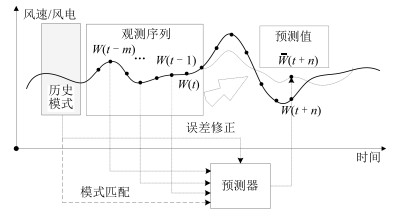
 下载:
下载:
